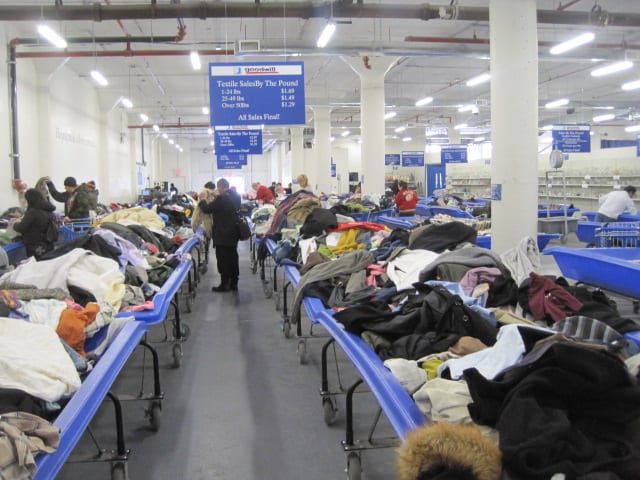
Hello and happy Wednesday everyone! ;-)
Yes, that picture above is the mecca of all thrifting meccas … the GOODWILL OUTLET in Queens, New York, where finding a fabulous piece takes some serious digging and a critical eye to separate the treasure from the trash.
Defining what true “treasure” is remains up to you — whether it’s finding a one-of-a-kind dress for a fraction of the cost, revealing a rack full of never-before-worn samples from your favorite contemporary brand or my favorite, spotting priceless vintage clothing brands hidden between the hangers — every thrift store experience presents boundless opportunity and discovery.
Valorie Huston, an Ebay seller and follower of Sammy Davis Vintage, recently asked the following question on the fan page.
For more information about tags and labels read my post about Vintage Clothing Labels and Tags.
I have been selling on eBay and I’m just beginning to venture into vintage clothing. Can anyone recommend some resources where I can find information on identifying vintage pieces? I make the rounds at our local Salvation Army Thrift Store, Goodwill, estate/garage sales and several locally owed thrift stores on a weekly basis. I have found some awesome pieces so far but I know I have missed tons of great buys because I don’t have a lot of knowledge/experience in vintage clothing.
So if anyone can pass along any information and/or resources where I can do some research on identifying vintage pieces I would really appreciate it. I know the labels from some designers have changed over the years and you can date a piece by the label. Hopefully I can learn the “tricks of the trade” and build up a nice inventory of vintage items so I can submit some pieces in the near future.
Her question inspired today’s post on 11 ways to know a thrift store piece is vintage by examining its labels and tags. Like the book of a cover, a brand’s tag and label speaks volumes to the piece’s style and production history. Plus, read this for advice how to date clothing as vintage.
Keep reading after the jump for 11 things to note when separating the “contemporary” from the “vintage” at a thrift store — and how this advice might help you identify vintage worth selling online, too!
Vintage identification is like anything in life: practice makes perfect. Vintage is technically a piece that is 20 years or older, however, many industry professionals refer to vintage as being “two decades or older,” — i.e., technically a piece from 1991 is vintage, but since we can’t always identify production year it is a safer bet to stick to the late ’80s or older as vintage.
I hope that the following tips will wet your appetite for more knowledge on recognizing vintage for its value and for its worth.
If you like this post’s information and find it useful, please click “like” next to the Twitter button above, and share it with friends and loved ones on Facebook & Twitter or just plain ‘ole email, too! I’d love to get feedback on articles of this type so that I can continue to use this site as a platform to educate, enlighten AND entertain you!
If you love vintage fashion and want to experiment with it, you probably already know how hard it is to find the right vintage look. There are a lot of things that can go wrong while dressing up in vintage styles – from the fit of your clothes to their quality, and even how long they can be worn. We’ll let you everything there is to know about finding the perfect vintage look!
Thanks for everything EVERYONE! Can’t wait to check in again tomorrow! And quick tease: BIG NEWS FOR FRIDAY! Some of my grandmother’s costume jewelry may finally be finding itself a happy home … with YOU!
xx, SD
1.) UNION LABELS
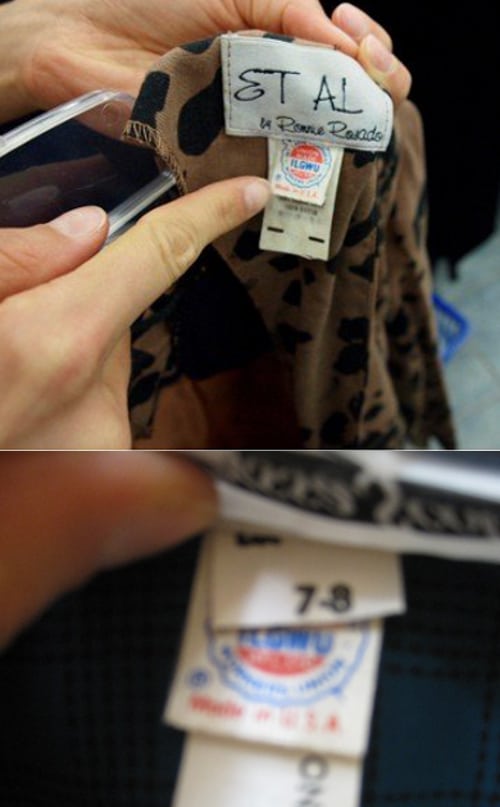
WHAT TO LOOK FOR: Below the inside brand label near the size is a “union” label that looks similar to what you see above.
They’re usually square and about 1/2-inch-by-1/2-inch; red, white, and blue; and state the name of the union, like “The Ladies Garment Workers Union” which is abbreviated on the label with LGWU.
VINTAGE INSIGHT: A union label is proof that the piece was produced and supported by a clothing union, which existed in the U.S. before the overseas boom of clothing production beginning in the 1980s.
Learn more about ILGWU union labels and how to use them to date your vintage clothing!
2.) ONE SIZE FITS ALL
WHAT TO LOOK FOR: Tags that proudly state “one size fits all”
VINTAGE INSIGHT: Have you seen a tag that says this lately? Chances are, probably not. The “one size fits all” was a fad in the ’80s — think oversized tees, sweatshirts, pants, dresses … you name it, and there was a “one size fits all” version of it!
The ’80s were a time of abundant oversize made wearable with big, bold belts, leg warmers and big hair. Everything was big … but like the tag said, everything “fit all”!
3.) LOT or STYLE NUMBERS
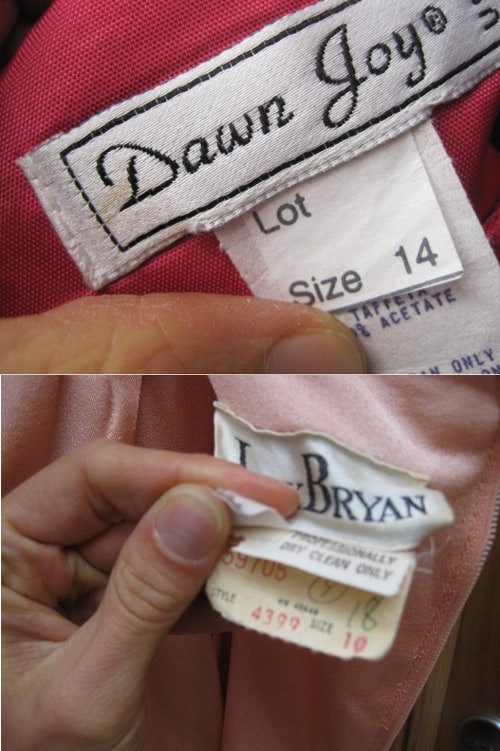
WHAT TO LOOK FOR: Below the brand label, an additional label that gives a “lot” or “style” number.
VINTAGE INSIGHT: Factories of decades ago kept track of clothing production not by computerized high technology, but by appending a numerical value to each item produced so that it was sorted and distributed properly. The “lot” number is the number attached to the group of pieces mass produced for a store.
So your vintage dress would be lot 10, which was the tenth group of that exact same dress produced in a certain factory. Lots 1-5 may have gone to department stores out west, while lots 6-10 may have stayed local.
The style number is different than lot because it’s referring to that piece’s exact design, i.e. style 49085 produced by that brand. It was a way for the brand to document the various styles of fashions it was producing.
4.) EXTRA LARGE TAGS
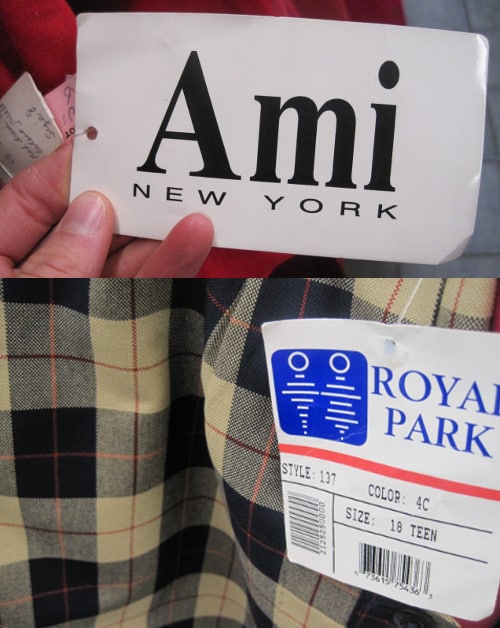
WHAT TO LOOK FOR: Extra large price tags
VINTAGE INSIGHT: I’m still researching why this was a trend of the ’80s, but “extra large tags” were found on almost every single piece of clothing sold in stores. I theorize that the oversized price tag trend speaks to the decade’s booming economy as well as our ignorance of sustainable efforts to limit paper waste.
Whatever the reason, tags were bigger and better 20-30 years ago. When you find a vintage piece in a thrift store with its original tags, you’ve most likely found a “dead stock” piece, the remainders of a department store or boutique that may have shut down and donated what remained of the store — tags and all — to a thrift store.
5.) LABELS NOTE BRAND CITIES OR ORIGIN OF MAKE
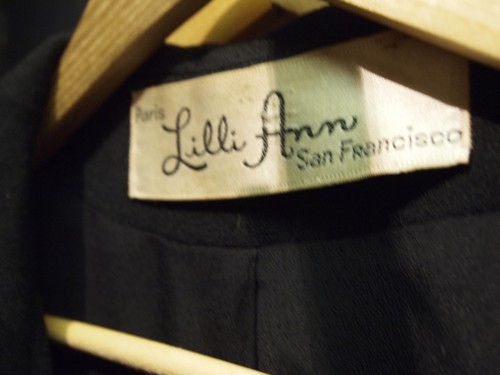
WHAT TO LOOK FOR: Brand labels with major cities cited alongside the brand name. Think “New York,” “Philadelphia,” “San Francisco,” “Paris,” “London,” etc.
VINTAGE INSIGHT: The trend of appending a city to a brand’s label speaks to the fact that women wanted to know that they were buying a piece originating from a major urban center. Today, our pieces are from mostly Asian countries. There is no style “panache” in seeing that your H&M dress was made in Taiwan.
In times of era’s past, purchasing your season’s styles from a brand that designed and made the pieces in San Franciso was something to speak of. If you lived in New York, getting those “west coast styles” may have been your fashion prerogative.
The same can be said for European designs. Woman wanted their clothing to be associated to a geographic location because the mass communications which exist today were non-existent then — we couldn’t, for example, Google “Parisian fashions” and click to buy.
In other words — styles from Paris stayed in Paris; styles from New York stayed in New York, etc. They were not duplicated and mass produced for a global fashion economy, because one had yet to formulate yet.
6.) MADE IN THE USA
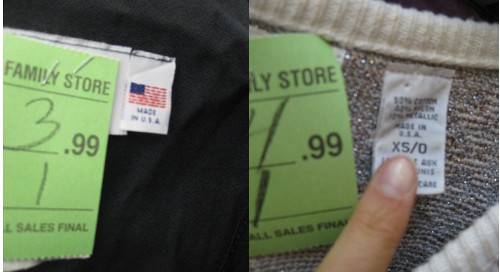
WHAT TO LOOK FOR: Any reference to being “Made in the USA” or “Made in America.” Label usually includes image of colored US flag, but sometimes [see right image] only states “Made in USA.”
VINTAGE INSIGHT: As unions lost production strength with the increased outsourcing of manufacturing to Asia and other countries abroad, companies opted to produce in the USA — but not with a union — which had higher production costs because of associated wages for employees. Brands would label clothing with this patriotic fact almost as compensation for not being made by a Union.
The “Made in USA” declaration became almost a fad with brands. Consumers, increasingly aware that their clothing was being made in China by the boatload, were looking for “American quality.”
While the quality difference may have been minimal, purchasing American-made became a top priority for consumers, thus declaring “Made in USA” on labels helped brand image by boosting sales.
7.) INTERESTING LABEL TYPOGRAPHY
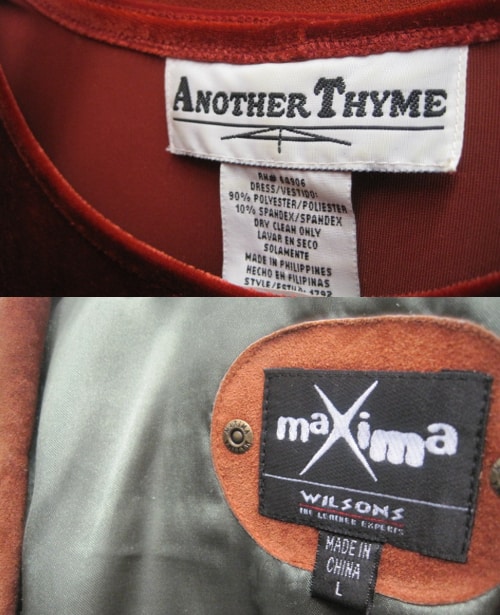
WHAT TO LOOK FOR: Interesting label typography
VINTAGE INSIGHT: This takes a more critical eye, however I argue that with a double take you can note the difference between label typography of today versus yesterday.
Note the two images above, both from labels designed with ’80s aesthetics in mind.
The labels are not simple in design. There was a consciousness in design here that reflected the style of the times. The “X” in Maxima is accentuated, and “A” and “T” in “Another Thyme” are slightly larger.
Also, the font is not a simple script or simple bold. Both fonts are more in the family of fun — like using goofy Comic Sans on a cover letter instead of the professional standard Times New Roman.
With practice, you’ll be able to tell the difference between brand typography of various decades. While thrifting, give every label a double-take to fine tune your vintage sixth sense!
8.) MADE IN COUNTRIES THAT NO LONGER EXIST
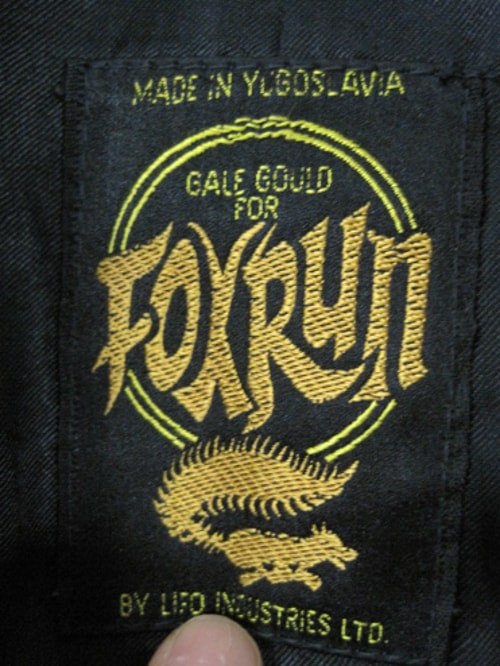
WHAT TO LOOK FOR: Labels that state item was made in a country that no longer exists, including Yugoslavia [above] or “Hong Kong British Colony,” among others.
VINTAGE INSIGHT: This takes some geography and history insight, too. It helps to understand international history when identifying a vintage piece, because every now and then you will stumble upon the name of a country no longer found on a map.
Yugoslavia was a Russian country which quite literally disappeared in the early ’90s when it was renamed “The Federal Republic of Yugoslavia,” consisting of countries Serbia and Montenegro.
In 2003, the “Federal Republic” part was completely dropped, and Serbia and Montenegro are what rename. So when looking at a label that reads “Yugoslavia,” you are looking at a piece that pre-dates at least 1992.
Another example: The British Crown Colonies of “Hong Kong” ceased to exist in 1997, when the country and its government were handed to People’s Republic of China. So in noting a label that reads “The British Crown Colonies of Hong Kong,” you are looking at a piece that pre-dates at least 1997.
9.) BRAND LABEL REDESIGN

WHAT TO LOOK FOR: Brand’s redesigning their labels as they re-aligned with the relevant style of the times and fashion culture.
VINTAGE INSIGHT: The above example shows the label change of The Limited, which was one of my favorite stores to visit at the mall as a teenager growing up in Pennsylvania. The labels above are not vintage, but date from late ’90s to early 2000s. The tag has probably been redesigned multiple times over the past decade.
When researching a vintage piece, many online expert sources will identify the various tags used by brands over the course of history. You can, for example, know if a piece was Yves Saint Laurent ’70s or ’80s based on knowledge about the tag design alone.
You can see these differences evolve over the years with designers who remain contemporary today — think Betsey Johnson, Donna Karen, Ralph Lauren. The people behind these design houses were branding their name as much as their apparel, so like we would change our personal style over the decades, they would change the design of their labels, too.
10.) THE PRICE ON ORIGINAL TAGS
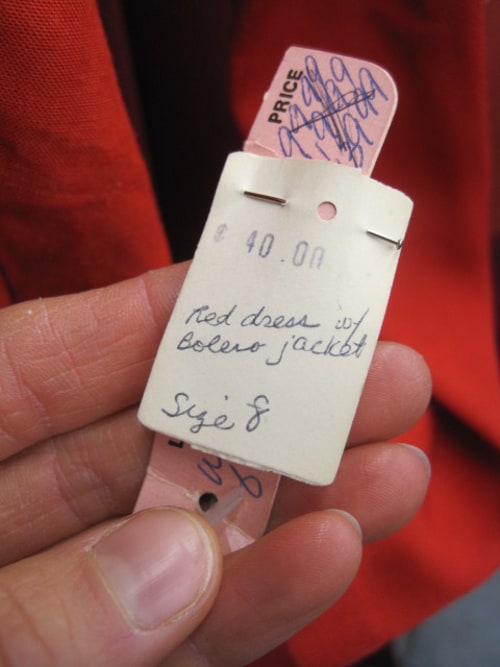
WHAT TO LOOK FOR: The original price on a tag, along with unusual construction/ink/materials.
VINTAGE INSIGHT: When you are lucky enough to stumble upon a vintage piece with the original tag, search hard for the price and for any “hole” markings that look like braille writing.
First, noting the price will give you a general understanding of when this piece might have been made, and its “quality” value during that era. The two-piece suit pictured above cost $40. This is about 1/8 the value of most department store quality suits today.
Looking at the price, I’d guess the suit dates from the early ’80s and sold in a privately owned store based on the fact that someone hand wrote on the tag itself.
Note the ink and staples used on this tag too: You’ll see that the machinery clearly was from another time, with stark differences in quality when compared to those clean, crisp contemporary tags we’re used to seeing.
Second, if you find a tag with what appears to be holes in it — it looks a lot like braille writing for the blind — you’ve found a piece that pre-dates the ’80s for sure. These holes were read by the equivalent of a cash register for price and documentation.
These are truly special tags and if you ever find a piece with one, you know for sure that you’ve got a vintage piece on your hand that is most likely from the ’60s or ’70s.
11.) DECORATIVE LABELS
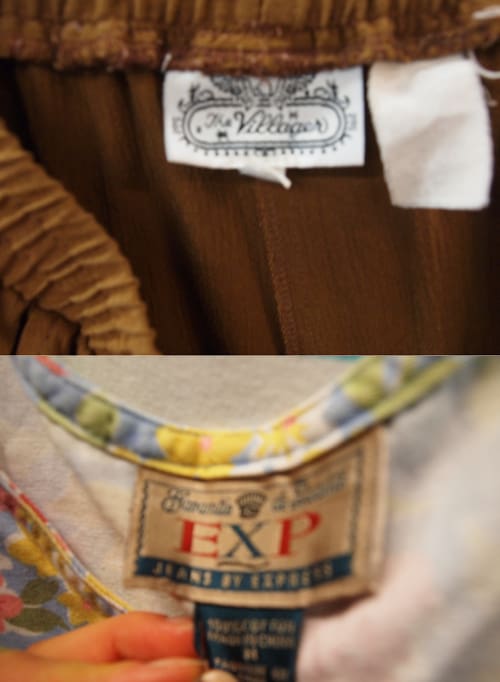
WHAT TO LOOK FOR: What seems to be exaggerated decoration & design on the brand labels. A bit cheesy & a bit unnecessary!
VINTAGE INSIGHT: Design of today and from the 2000s is simple, sleek and sexy. Using flowers or other symbols, gaudy typography or even various colors is not something we see today. What we see mostly is a stark contrast of colors on a small, simple label that sometimes is appended on the side of the shirt, versus the top of the neck.
The labels of yesterday were something special. The label design spoke to the design of the clothing itself — “The Villager” label above is from a popular ’60s & ’70s brand that I’ve found often thrifting. The clothing was for junior aged girls.
The early ’90s Express brand label uses red, white and blue colors and because of this color palette, has a very patriotic feel. In the late ’80s & early ’90s, Express was known as “Express Campaigne Internationale” — a very subtle throwback to Parisian roots.
Later on in the ’90s, the brand became a symbol of the American Girl and the “cool” American Girl’s choice of jeans, hence the choice of patriotic colors in the tag above.

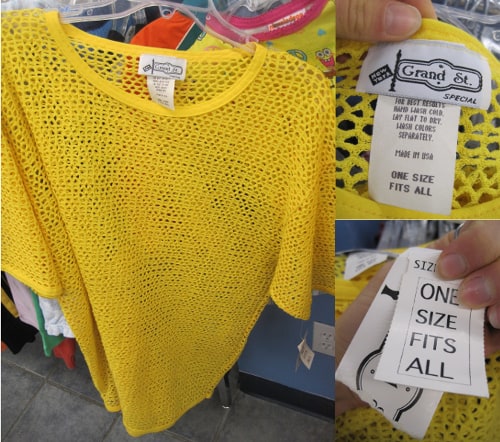
this is great. you’ve hit every point i’ve run into while searching for vintage. I’d say the union labels and brand label redesign are the two most common indicators.
Very educational… I’m now beginning to collect vintage clothing…I love the touch of history ..thank you so much…more power!!!
great post and tips on searching for vintage items. I would also advise going to Church sales. They have great pieces.
Thanks so much! Very insightful & useful info!
This is SO helpful. Every weekend I’ve been hitting up the thrift stores and while I use some tricks to check and see if something is vintage, most of these I never even thought of! Thanks so much! Hopefully I can score the motherload tomorrow! :)
EXCELLENT post! I too have recently starting thrifting for more vintage pieces and the information above really clarifies what I need to look for. Thanks!
Great article! I’m always looking for new tips on correctly identifying what pieces are vintage and which aren’t quite there yet. I picked up a few new techniques today that will definitely be useful in my next hunt!
i hardly ever read the labels. if i like it and it fits i usually just get it :x
KeepItFvncy,
M.E.
Great tips! I had to share w/my friends! They are always asking me how I find vintage pieces, this sums it all up! Thanks!
Reyna
@Glamour Glory
Hi Sammy – great post! I would add that the quality of the labels themselves is also often an indicator. For instance, higher end garments often had embroidered labels right through the 1960’s then, when ready to wear became mainstream and the economy tanked heading into the seventies, most labels were printed, and, often printed cheaply. (by the 1990’s embroidered labels come back as a standard, but, as you point out, with fonts and designs that are a more refined and modern aesthetic) Earlier high-end garments often have a manufacturer/designed label along with a shop label. You often see shop labels on coats and fancy dresses through the 60’s. Also, garments were not required to show fabric content until some point in the 1960’s (I forget the exact date), so, anything you see with content listed is later than that. The chronological order for mass-produced (i.e.; not high end) overseas is (not exactly) but about 1960’s- Japan; 1970’s: Korea & Taiwan, 1980’s: Taiwan + some China + Eastern European (like the Yugoslavia you show); 1990’s Sinagpore, Malaysia, China, Indonesia start to become common…
Excellent additional points, Christine. One favorite quality vintage brand for blouses is Jaeger. These tags list London-Paris-New York and Made in Switzerland. Their look is rather contemporary & the stitching always fine.
Also, check out older brands on Wiki to see if & when they were sold, as that sometimes affected the way the clothes were manufactured. I’m thinking of Evan-Picone, Made in New York, which was top quality from the early 50s to late 60s, selling in the best Fifth Ave stores. If you have a Saks or Lord & Taylor on your Evan-Picone it’s usually vintage. However, Revlon bought the company, eventually producing overseas – and it shows.
I love your blog!
This post is amazing and by far one of my faves!
I always look forward to what new vintage adventures you post!
Excellent article, Sammy!
All my clothes are vintage because I never buy new ones. My wife says they’re just old but I’m pretty vintage. Now I have to take her shopping. For her, not me:)
this is some great information! for the union labels, we just know that it was produced before 1980? is that what it means?
Just for information Yugoslavia was not a Russian country!
BR
Hi Sammy,
First I want to thank you for your articles. I have learned quite a lot from reading them. I just finished reading an article of yours on dating by the label. One of the labels you used as an example was “Chetta B” which by your research was founded in 1995. Now…the only reason I ran another searched after reading your article is because I have a fromal dress that I picked up the other day that is identical to a dress that an old friend had purchase between 1982-1984 that I absolutely loved, but because I could not remember the label of that dress…I could not be completely sure that the dress I found was just from that time. After doing a bit of research on “Cheeta B” I found a (included website)site that states that the company was founded in the 80’s which would also match the time frame of the dress that my friend purchase.
Thanks again for your informative articles!!!
I have a question. It has been pointed out on this site that a garment with a label which states “made in the British Crown Colonies of Hong Kong” is vintage. I have a number of garments with labels that state “made in Hong Kong” would these items be considered vintage?
hi Susan! Hong Kong gained independence in 1999, so if you have a piece of clothing with a tag that says “Made in the British Colonies of Hong Kong” you know it is at least pre-1999. You have to look at clothing style, production and other aspects of the label to determine if it’s TRULY vintage from there, which is technically anything from 1992 or earlier. I hope this helps and thank you for this question!!
WOW! This is the article I’ve been WAITING for!!!!
love, polly :D
Thank you Polly! ;-) I have many future articles on similar content. Please let me know if you have any special requests! Vintage love xx
I AM LOOKING FOR THE OLD LADYBUG CLOTHES, LIKE VILLAGER, AND THE LITTLE LADY BUG PIN THAT WENT WITH IT. I HAD A FEW OF THEM YEARS AGO, AND GAVE THEM AWAY. HOW DO I FIND THEM ON THE INTERNET SEARCH ENGINE…WHAT WOULD YOU SUGGEST I TYPE IN. I HAVE TRIED EVERYTHING, BUT NOTHING POPPED UP. CAN YOU PLEASE ADVISE…MUCH GRATITUDE AND LOVE TO YOU AND YOURS
I left a post regarding a search for the Ladybug clothing line on ebay but upon further inspection I realize I may be wrong about the particular garments I was looking at. I mentioned the Vintage Fashion Guild, http://www.vintagefasionguild.org and their description for “Villager”. The author has a site, fuzzylizzie.com, which sells vintage clothing, I imagine she sells the Villager line of clothing and wouls also know where and how to find the garments.
I have misspelled vintagefashionguild.org
hi Alisa! I believe Susan gave you some AMAZING advice (thank you Susan!!) and that should help you find the pieces you are looking for. If you have any further questions please don’t hesitate to email me!
Vintage Fashion Guild has information on the background of the Villager company and Ladybug clothing, which was their junior line. Their members can be contacted for items that are for sale. I just went into ebay, typed “Ladybug” into the search engine and then selected “clothing, shoes and accessories”, then “vintage”. There are a number of “Ladybug” items for sale at the moment.
Susan, the Vintage Fashion Guild is such a great resource, thank you for sharing this! You are a light in the vintage world. Thank you for sharing your knowledge!
How can you tell the story of a vintage outfit if there is no tag at all? I have a really neat outfit that I have been told is 1950’s vintage, its heavy due to the bead work. Its very well made.
I found your info. on union tags really helpful, but I have a women’s blazer/jacket with a brand label of “Saxony of California” and can’t find even an acknowledgement of this company anywhere. It’s a wool jacket with padded shoulders that belonged to my mother. I’m thinking it’s 40’s era, but do you have any idea about the name label?
What age paper(-ish) label material indicate? Were they widespread before 80s? Were they completely out of use in 90s?
I have some clothes with labels made of such material, they seem vintage, I’m guessing they’re fron 80s, but I would like to hear your opinion.
Thanks for the info. I too am an eBay reseller and have done OK with some clothing that I sell. This information however opens up another door to a more elaborative sales direction. Not going vintage all the way but definitely going to keep my eyes peeled for Vintage stuff out there. THANKS!
What a data of un-ambiguity and preserveness of valuable experience regarding unpredicted
feelings.
Review my web page – Linda
This article is amazing. I read it a while back and the tips are always in the back of my head when shopping for new items for my store. It’s always so exciting to find great pieces and then look at the tags to confirm they are truly vintage. Thanks for this wonderful article.
thank you. for saying this. I’m working on packaging all of the content around dating vintage into a free ebook. stay tuned ;-)
Hello there! I just would like to offer you a big thumbs up for the great info you’ve got right here on this post. I am returning to your blog for more soon.
My webpage – Home Page
Hello! I know this is kinda off topic but I was wondering if you knew where I
could find a captcha plugin for my comment form? I’m using the same blog platform as yours and I’m
having difficulty finding one? Thanks a lot!
Feel free to visit my blog; Williemae
Reupholstering your current lounge suite is a wonderful technique to begin a renovation to your living quarters.
It is much more cost-effective compared to purchasing a new set and sometimes quicker
than waiting for delivery of your King.
Have you thought-about making use of nests of tables for a coffee
table? When I lived in my university room, because
it was very small, I ended up making use of them continuously and they’re wonderful
Visit my weblog: Trena
If you are looking for organic and natural newborn clothing then really don’t even think about going to the shops, instead head straight online as you get a lot better variety that you just can’t find on the high street
My site; Jannie
I absolutely love your website.. Great colors & theme.
Did you develop this amazing site yourself?
Please reply back as I’m wanting to create my own personal website and would love to learn where you got this from or just what the theme is named. Many thanks!
Also visit my weblog Latesha
One way to know it is NOT vintage is to see a Spanish translation of an English label, starting with “Hecho en”…
These translations didn’t appear until around 2000, and the label you show for interesting graphics, Another Thyme, shows that the name was not trademarked for use until 1995.
http://www.trademarkia.com/another-thyme-85116743.html
I search trademarkia.com for the brand name and use the filters: clothing products, all dates, live or dead.
I have a Audrey Hepburn style gown that’s made of a black metallic mesh material. It came with fingerless elbow length gloves of same material. I purchases it from a vintage clothing store/antique shop in Saratoga, NY in the early 70s. The problem is there are no tags anywhere on it or the gloves. I doubt this was a mass produced piece since it is very daring. Any idea how I would find out who designed this gown? Thanks for any info.
that was a Great and informative post. thanks for Sharing
That’s what i call true vintage! Thanks
Hello!
Great info on here! I wanted to share another way of narrowing down the vintage clothing item. It’s the SIZE. Over the decades, the clothing size “number” has gone down, due to women wanting “vanity sizing”. So if you find a dress that says size 12… but fits like a 6 – it’s definitely vintage and probably from the 1960’s. If it fits like a 6, and it says size 14 – then most likely it’s from the 50’s. Sizes of 0, 2 and 4 were unheard of.
Thanks for Sharing.
This is awesome! One thing that is also rad is the amount of retro brands that are coming back! When I was growing up in the 80s and 90s, all of the cool kids had Gecko Hawaii, T&C, and Gotcha shirts — with SUPER bright neons, which practically don’t exist anymore because nowadays people use digital printers, which make colors way less vivid, cheaper, and print on demand. I did recently discover that Gecko Hawaii came back about a year ago and they are doing what they call the “Retro Printing Process” with puffed inks and CRAZY beautiful, nostalgic neons and colors. I got one and it literally brought me back to that exact time period in my life. I HIGHLY recommend getting one of their shirts for anyone into a serious clean/vintage retro look — I don’t think there is anything else quite like it. Their shop is geckohawaii and just visiting the site will bring you back in time. I’ve started combing eBay for their old stuff, but I think the new stuff is brighter, better, and cleaner! :)
Great article! thank you for taking the time to share this information.
Love this! I have recently really been getting into vintage clothing not only for myself but for my small business of reselling clothes and other things, while I have learned some tricks to tell if it’s vintage or not these tips have been very helpful for me to be knowledgeable when writing a description on my garments and when out hunting for gold! Thanks so much for sharing this!
Hey Sammy, thank you for sharing such an informative blog. This blog simply changes one’s perspective on vintage fashion in a positive way.
Hello i have a full length coat not sure about which fur it is but it has a AF trademark and the name c w martin & sons how can i find out more about its origins please